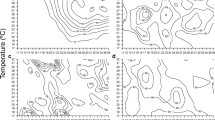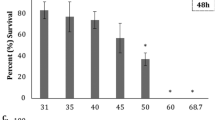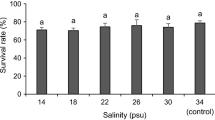Abstract
The embryonic developmental response of two abalone species (disk abalone Haliotis discus discus, giant abalone Haliotis gigantea) to a drop in salinity with different exposure times was investigated to gain a better understanding of the reasons for the decrease in natural stock populations. Two experimental designs—first, combinations of two salinities (34 and 17 psu) and four exposure times (0, 1, 2 and 4 h), and second, combinations of three salinities (34, 24 and 14 psu) and four exposure times (0, 1, 3 and 6 h)—were tested on disk and giant abalone eggs to determine the effects on hatching onset time, hatching success, percentage of abnormality and survival rate. Hatching onset time increased significantly for both species as salinity dropped and exposure time increased. Both species followed a decreasing trend in terms of hatching success as exposure time increased at low salinity levels. As for abnormality, both species showed a significant negative effect of low salinity and long exposure times. Giant abalone showed better adaptability to long exposure time at low salinity levels, and hence a higher survival rate, than disk abalone.


Similar content being viewed by others
References
Arisman N, Istiqomah N, Yoshimatsu T (2018) Impact of short-term hyposalinity stress on Akoya pearl oyster (Pinctada fucata). Asian Fish Sci 31:265–275
Bayne BL, Thompson RJ, Widdows J (1976) Marine mussels: their ecology and physiology. In: Bayne BL (ed) Physiology I. Cambridge Scientific Press, Cambridge, pp 121–206
Charmantier-Daures M, Charmantier G, Trilles JP (1988) Tolerance a la salinite et osmoregulation chez les post-larves de (Penaeus japonicus) et P. chinensis Effet de la temperature. Aqua Liv Res 1:267–276
Chen J, Chen W (2000) Salinity tolerance of (Haliotis diversicolor supertexta) at different salinity and temperature levels. Aquaculture 181:191–203
Cheng W, Juang F, Chen J (2004) The immune response of taiwan abalone (Haliotis diversicolor supertexta) and its susceptibility to Vibrio parahaemolyticus at different salinity levels. Fish Shellfish Immunol 16:295–306
Cook PA (2016) Recent trends in worldwide abalone production. J Shellfish Res 35:581–583
Davenport J, Gruffydd LID, Beaumont AR (1975) An apparatus to supply water of fluctuating salinity, and its use in the study of the salinity tolerance of the larvae of scallop (Pectin maximus L.). J Mar Biol Assoc UK 55:391–409
Guerin JL, Stickle WB (1997) Effect of salinity on survival and biogenetics of juvenile lesser blue crabs (Callinectes similis). Mar Biol 129:63–69
Inoue M (1976) Stocking effectiveness of abalone. In: The Japanese Society for Fisheries Science (ed) Stocking effectiveness of Fish and Shellfish. Koseisha-Koseikaku, Tokyo, pp 9–25 (in Japanese)
Japan Meteorological Agency (2018) 1.2 Climate in Japan. In: Japan Meteorological Agency (ed) Climate Change Monitoring Report 2017. Japan Meteorological Agency, Tokyo, pp 16–21
Kashenko SD (2000) Acclimation of sea cucumber (Apostichopus japonicus) to decreased salinity at the blastula and gastrula stages: its effect on the desalination resistance of larvae at subsequent stages of development. Rus J Mar Biol 26:422–426
Kirkpatrick K, Jones MB (1985) Salinity tolerance and osmoregulatory of a prawn (Palaemon affinis) Milne Edwards (Carida: Palaemonidae). J Exp Mar Biol Ecol 93:61–70
Kitada S (1999) Effectiveness of Japan's stock enhancement programmes: current perspectives. In: Howell BR, Moksness E, Svåsand T (eds) Stock enhancement and sea ranching. Blackwell Publishing, Oxford, pp 103–131
Kitada S, Kishino H (2006) Lessons learned from Japanese marine finfish stock enhancement programmes. Fish Res 80:101–112
Legat JFA, Puchnick-Legat A, Gomes CHAM, Suhnel S, de Melo CMR (2017) Effects of salinity on fertilzation and larviculture of the mangrove oyster (Crassostrea gasar) in the laboratory. Aquaculture 468:545–548
Madrones-Ladja JA (2002) Salinity effect on the embryonic development, larval growth and survival at metamophosis of (Placuna placenta) Linnaeus (1758). Aquaculture 214:411–418
Masuda R, Tsukamoto K (1998) Stock enhancement in Japan: review and perspective. Bull Mar Sci 62:337–358
Musashi T (2006) Stocking effectiveness of Ezo abalone Haliotis discus hannai in Iwate Prefecture Japan. Nippon Suisan Gakkaisha 72:467–470 (in Japanese)
Oba T (2000) Awabi bunka to nihonjin. Seizando Shoten, Tokyo (in Japanese)
O'Connor WA, Lawler NF (2004) Salinity and temperature tolerance of embryos and juveniles of pearl oyster (Pinctada imbricata) Röding. Aquaculture 229:493–506
Paul JD (1980) Salinity-temperature relationships in the green scallop (Chlamys opercularis). Mar Biol 56:295–300
Pechenik JA (1983) Egg capsules of (Nucella lapillus) protect against low low-salinity stress. J Exp Mar Biol Ecol 71:165–179
Przeslawski R (2004) A review of the effects of environmental stress on embryonic development within intertidal gastropod egg masses. Molls Res 24:43–63
Richmond CE, Woodin SA (1996) Short-term fluctuations in salinity: effects on planktonic invertebrate larvae. Mar Ecol Prog Ser 133:167–177
Saido T (2002) Recovery of the abalone Haliotis discus hannai and its causes in Iwate Prefecture Japan. Kaiyo Mon 34:477–481 (in Japanese)
Sasaki R (2005) Abalone. In: Mori K (ed) Aquaculture system Vol. 3: Molluscs, Crustaceans, Sea Urchins and Algae. Koseisha Koseikaku, Tokyo, pp 85–120 (in Japanese)
Seki T, Sano M (1998) An ecological basis for the restoration of Japanese abalone populations. Bull Tohoku Natl Fish Res Inst 60:23–40 (in Japanese with English abstract)
Seki T, Taniguchi K (2000) Rehabilitation of northern Japanese abalone, Haliotis discus hannai populations by transplanting juveniles. Can Spec Publ Fish Aquat Sci 130:72–83
Singhagraiwan T, Doi M, Sasaki M (1992) Salinity tolerance of juvenile donkey's ear abalone, (Haliotis asinina L.). Thai Mar Fish Res Bull 3:71–77
Strand O, Solberg PT, Andersen KK, Magnesen T (1993) Salinity tolerance of juvenile scallops (Pecten maximus L.) at low temperature. Aquaculture 115:169–179
Struhsaker J, Costlow JJ (1969) Some environmental effects on the larval development of (Littorina picta) Mesogastropoda, reared in the laboratory. Malacologia 9:403–419
Verween A, Vincx M, Degraer S (2007) The effect of temperature and salinity on the survival of (Mytilopsis leucophaeata) larvae (Mollusca, Bivalvia): The search for environmental limits. J Exp Mar Biol Ecol 348:111–120
Acknowledgements
The authors would like to acknowledge the Mie Prefectural Sea Farming Center and its staff for providing fertilized eggs of both species of abalone to carry out this study.
Author information
Authors and Affiliations
Corresponding author
Additional information
Publisher's Note
Springer Nature remains neutral with regard to jurisdictional claims in published maps and institutional affiliations.
Rights and permissions
About this article
Cite this article
Manuel, A.V., Tu, P.T.C., Tsutsui, N. et al. Effect of salinity change and exposure time on the egg stages of two abalone species Haliotis discus discus and H. gigantea. Fish Sci 86, 27–33 (2020). https://doi.org/10.1007/s12562-019-01366-4
Received:
Accepted:
Published:
Issue Date:
DOI: https://doi.org/10.1007/s12562-019-01366-4




